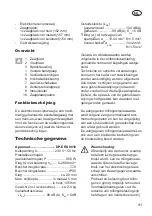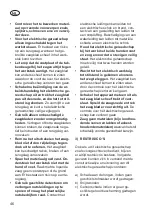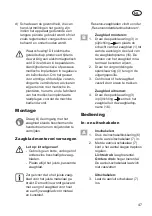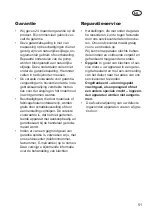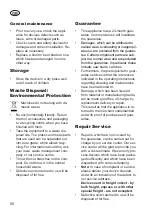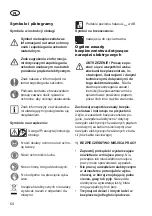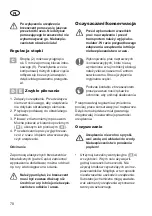
55
GB
radiators, ranges and refrigerators.
There is an increased risk of elec-
tric shock if your body is earthed or
grounded.
• Do not expose power tools to rain
or wet conditions.
Water entering
a power tool will increase the risk of
electric shock.
• Do not abuse the cord. Never use
the cord for carrying, pulling or un-
plugging the power tool. Keep cord
away from heat, oil, sharp edges or
moving parts.
Damaged or entan-
gled cords increase the risk of electric
shock.
• When operating a power tool out-
doors, use an extension cord suit-
able for outdoor use.
Use of a cord
suitable for outdoor use reduces the
risk of electric shock.
• If operating a power tool in a
damp location is unavoidable, use
a residual current device (RCD)
protected supply.
Use of an RCD
reduces the risk of electric shock.
3) PERSONAL SAFETY
• Stay alert, watch what you are do-
ing and use common sense when
operating a power tool. Do not use
a power tool while you are tired or
under the influence of drugs, alco
-
hol or medication.
A moment of inat-
tention white operating power tools
may result in serious personal injury.
• Use personal protective equipment.
Always wear eye protection.
Protec-
tive equipment such as dust mask,
non-skid safety shoes, hard hat, or
hearing protection used for appropriate
conditions will reduce personal injuries.
• Prevent unintentional starting.
Ensure the switch is in the off-
position before connecting to power
source and/or battery pack, picking
up or carrying the tool.
Carrying pow-
er tools with your finger on the switch
or energising power tools that have the
switch on invites accidents.
• Remove any adjusting key or
wrench before turning the power
tool on.
A wrench or a key left at-
tached to a rotating part of the power
tool may result in personal injury.
•
Do not overreach. Keep proper foot-
ing and balance at all times.
This
enables better control of the power tool
in unexpected situations.
•
Dress properly. Do not wear loose
clothing or jewellery.
Keep your hair,
clothing and gloves away from moving
parts. Loose clothes, jewellery or long
hair can be caught in moving parts.
•
If devices are provided for the con-
nection of dust extraction and col-
lection facilities, ensure these are
connected and properly used.
Use of
dust collection can reduce dust-related
hazards.
• Do not allow yourself to be lulled
into a false sense of security and
do not disregard the safety rules for
power tools, even if you are familiar
with the power tool after using it
many times.
Careless action can lead
to serious injuries within a fraction of a
second.
4) POWER TOOL USE AND CARE
•
Do not force the power tool. Use the
correct power tool for your applica-
tion.
The correct power tool will do
the job better and safer at the rate for
which it was designed.
•
Do not use the power tool if the
switch does not turn it on and off.
Summary of Contents for DP-ERS 8010
Page 2: ...1 2 3 4 6 7 8 5 9 9 3 1 16 2 1 9 ...
Page 126: ...126 20200715_rev00_cflopAe ...
Page 128: ......

